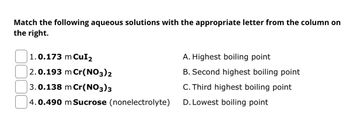
Chemistry
10th Edition
ISBN: 9781305957404
Author: Steven S. Zumdahl, Susan A. Zumdahl, Donald J. DeCoste
Publisher: Cengage Learning
expand_more
expand_more
format_list_bulleted
Question

Transcribed Image Text:Match the following aqueous solutions with the appropriate letter from the column on
the right.
1.0.173 m CuI₂
2.0.193 m Cr(NO3)2
3.0.138 m Cr(NO3)3
4.0.490 m Sucrose (nonelectrolyte)
A. Highest boiling point
B. Second highest boiling point
C. Third highest boiling point
D. Lowest boiling point
Expert Solution
arrow_forward
Step 1: Colligative properties:
The colligative properties are those properties of solutions that depend on the number of solute particles, and not depend on the nature of the solute particles. The number of solute particles can be related to the molality of the solution. These properties depend on the nature of the solvent.
Step by stepSolved in 4 steps with 1 images

Knowledge Booster
Learn more about
Need a deep-dive on the concept behind this application? Look no further. Learn more about this topic, chemistry and related others by exploring similar questions and additional content below.Similar questions
- Which aqueous solution will have the lowest freezing point? ATf = Kf m i a. 0.05 m MgCl2 b. 0.05 m KBr c. 0.1 m LİCI O d. 0.1 m Na2SO4arrow_forwardMatch the following aqueous solutions with the appropriate letter from the column on the right. fill in the blank 1 1. 0.153 m CaCl2 A. Highest boiling point fill in the blank 2 2. 0.260 m NaCl B. Second highest boiling point fill in the blank 3 3. 0.163 m CoCl2 C. Third highest boiling point fill in the blank 4 4. 0.430 m Sucrose (nonelectrolyte) D. Lowest boiling pointarrow_forwardFor questions #8, #9, #10, and #11- From the following: a. pure water b. 0.01 m aqueous solution of C12H22O11 c. 0.01 m aqueous solution of NaCl d. 0.01 m aqueous solution of CaCl2. #8. Choose the one with the highest freezing point. #9. Choose the one with the lowest freezing point. #10. Choose the one with the highest boiling point. #11. Choose the one with the lowest boiling point .arrow_forward
- Choose the aqueous solution that has the lowest melting point. There are all solutions of nonvolatile solutes. A) 0.150 m CaCl2 B) 0.200 m C6H12O6 C) 0.125 m NaCl D) 0.100 m AlCl3 E) They all have the same melting point.arrow_forwardMatch the following aqueous solutions with the appropriate letter from the column on the right. 1.0.183 m MgCl₂ A. Highest boiling point 2.0.290 mAgCH3COO B. Second highest boiling point 3.0.260 m Bas 4.0.490 m Urea (nonelectrolyte) C. Third highest boiling point D. Lowest boiling pointarrow_forwardTwo aqueous solutions are prepared: 2.0 m Ca(NO3)2 and 2.0 m KBr. Which of the following statements is true? A. The Ca(NO3)2 solution has a higher vapor pressure and lower freezing point than the KBr solution. B. The Ca(NO3)2 solution has a lower vapor pressure and higher freezing point than the KBr solution. C. None of these are correct. D. The Ca(NO3)2 solution has a higher vapor pressure and higher boiling point than the KBr solution. E. The Ca(NO3)2 solution has a lower vapor pressure and higher boiling point than the KBr solution.arrow_forward
arrow_back_ios
arrow_forward_ios
Recommended textbooks for you
 ChemistryChemistryISBN:9781305957404Author:Steven S. Zumdahl, Susan A. Zumdahl, Donald J. DeCostePublisher:Cengage Learning
ChemistryChemistryISBN:9781305957404Author:Steven S. Zumdahl, Susan A. Zumdahl, Donald J. DeCostePublisher:Cengage Learning ChemistryChemistryISBN:9781259911156Author:Raymond Chang Dr., Jason Overby ProfessorPublisher:McGraw-Hill Education
ChemistryChemistryISBN:9781259911156Author:Raymond Chang Dr., Jason Overby ProfessorPublisher:McGraw-Hill Education Principles of Instrumental AnalysisChemistryISBN:9781305577213Author:Douglas A. Skoog, F. James Holler, Stanley R. CrouchPublisher:Cengage Learning
Principles of Instrumental AnalysisChemistryISBN:9781305577213Author:Douglas A. Skoog, F. James Holler, Stanley R. CrouchPublisher:Cengage Learning Organic ChemistryChemistryISBN:9780078021558Author:Janice Gorzynski Smith Dr.Publisher:McGraw-Hill Education
Organic ChemistryChemistryISBN:9780078021558Author:Janice Gorzynski Smith Dr.Publisher:McGraw-Hill Education Chemistry: Principles and ReactionsChemistryISBN:9781305079373Author:William L. Masterton, Cecile N. HurleyPublisher:Cengage Learning
Chemistry: Principles and ReactionsChemistryISBN:9781305079373Author:William L. Masterton, Cecile N. HurleyPublisher:Cengage Learning Elementary Principles of Chemical Processes, Bind...ChemistryISBN:9781118431221Author:Richard M. Felder, Ronald W. Rousseau, Lisa G. BullardPublisher:WILEY
Elementary Principles of Chemical Processes, Bind...ChemistryISBN:9781118431221Author:Richard M. Felder, Ronald W. Rousseau, Lisa G. BullardPublisher:WILEY

Chemistry
Chemistry
ISBN:9781305957404
Author:Steven S. Zumdahl, Susan A. Zumdahl, Donald J. DeCoste
Publisher:Cengage Learning

Chemistry
Chemistry
ISBN:9781259911156
Author:Raymond Chang Dr., Jason Overby Professor
Publisher:McGraw-Hill Education

Principles of Instrumental Analysis
Chemistry
ISBN:9781305577213
Author:Douglas A. Skoog, F. James Holler, Stanley R. Crouch
Publisher:Cengage Learning

Organic Chemistry
Chemistry
ISBN:9780078021558
Author:Janice Gorzynski Smith Dr.
Publisher:McGraw-Hill Education

Chemistry: Principles and Reactions
Chemistry
ISBN:9781305079373
Author:William L. Masterton, Cecile N. Hurley
Publisher:Cengage Learning

Elementary Principles of Chemical Processes, Bind...
Chemistry
ISBN:9781118431221
Author:Richard M. Felder, Ronald W. Rousseau, Lisa G. Bullard
Publisher:WILEY